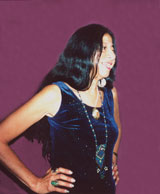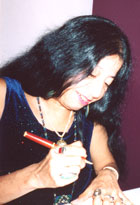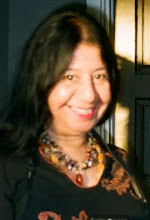Lorna Dee Cervantes, DRIVE: The First Quartet Reviewed in SPEAKEASY & New Pub Pics


This could be me signing your book if you order direct from the horse's hands. (Me: Born Year of the Horse in Chinese calendar. And, Ahau, Yellow Sun in the Tzolkin, the Mayan calendar -- which is the one I follow. Ha! Yellow Sun-Horse.)
~~~~~~~~~~~~~~~~~~~~~~~~~~~~~~~~~
* Note: Click on the pics to go to my flickr site. I have foto hay(na)ku poems there -- some from pics taken days after Wilma hit Isla Mujeres, Mexico.
~~~~~~~~~~~~~~~~~~~~~~~~~~~~~~~~~
Bryce has revamped my webpage on Wings, and added the review copy along with these pics he took of me at the Texas debut of DRIVE: The First Quartet. These were taken Oct. 17, 2005 at Trinity University yukkin' it up with new and old buds, by the look of the grin, this must be after the performance: "YEA! It's OVER!" You can go to the Wings website if you're looking for bio info in a hurry. Otherwise, search this site for more than anyone would possibly want to know.
~~~~~~~~~~~~~~~~~~~~~~~~~~~~~~~~~
Lorna Dee Cervantes

Drive: The First Quartet
DRIVE INCLUDES FIVE SEPARATE WORKS:
How Far's the War? • BIRD AVE
Play • Letters to David • Hard Drive
NOTE: Cover art by Irving Norman.
Interior paintings by Dylan Morgan.
Photos by Bryce Milligan.
TRADE EDITION PUBLICATION DATE: JANUARY 2006
DRIVE • ISBN: 0-930324-54-4 • 308 pages • Hardback • $24.95
Converted ISBN: 978-0-930324-54-4
A SPECIAL LIMITED EDITION AVAILBLE IN APRIL 2006:
DRIVE • ISBN: 0-916727-14-9 • $250 • Limited to 100 numbered
and signed, specially bound, in a hand-made wooden box
Advance pre-paid orders are being taken now.
Reserve your copy before they are all gone.
"This is a landmark work." – Mart’n Espada
Drive "reestablishes Cervantes as a singular voice."
– Publishers Weekly
" This is what it means to be a poet." – Ana Castillo
"She taught us that poetry can change the world." – Sandra Cisneros
"Cervantes is a poetic force to be reckoned with." - Women in the Arts (publication of The National Museum of Women In the Arts)
About DRIVE:
This is a landmark work. Lorna Dee Cervantes is not only an important Chicana poet; she is an important American poet, and her voice comes to us again, after many years, at a time when we desperately need to hear that voice. In fact, there are many voices here: the voice of protest against the atrocities committed in the name of coffee and bananas, the voice of the suffocated poor in the barrio and Latin America, the voice of girls fighting to survive on the street, the voice of jazz from the 78s of the past, the voice of praise for ancestors and the next generation, all voices of the most profound energy, compassion, strength, wisdom. "Come and see the blood in the streets," Neruda wrote. Lorna Dee Cervantes knows the blood in the streets and the blood of the heart, the blood that spills and the blood that keeps us alive. Come and see.
~ Martín Espada
This is what it means to be a poet, I tell myself, reading the thick, rich poems of Lorna Dee Cervantes' new collection. A poet is a "one winged dove." She is a "copper kettle," a "tuna-tamed tiger" and the "thundering of a hummingbird's wings." These images and many more are among Cervantes' treasure trove of poetic labors. If you love poetry, you've come to the right place. Throughout these pages, be prepared to feast your heart.
– Ana Castillo
About Lorna Dee :
As young writers we grew up alongside Lorna Dee Cervantes. When no one else was listening, she published us, encouraged us, guided us. Her work was the light we turned towards directing us towards a poetry of lyricism and social activism. She taught us that poetry can change the world.
~ Sandra Cisneros
Lorna Dee Cervantes is a daredevil.We are transfixed as she juggles rage, cruelties, passion. There is no net. Seven generations uphold the trick of survival. No one is alone in this amazing act of love.
– Joy Harjo
~~~~~~~~~~~~~~~~~~~~~~~~~~~~~~~~
From Speakeasy Magazine (Reviewed Winter 2005-2006)
IF Consideration of the Guitar and My Nature Is Hunger say something about the range of Chicano writing in the United States at this juncture, Lorna Dee Cervantes's Drive: The First Quartet on its own presents a wide variety of content, style, and approaches. The first poetry book by Cervantes to be published since 1991, Drive is made up of five distinct sections – most of which could stand on their own as strong books of poems. Across their sections, we find Cervantes as the political poet of witness, Cervantes the young girl in a California barrio, Cervantes in her years as a developing poet, and Cervantes the teacher.
The collection's first section, "How Far's the War," connects contemporary aggression and war in the Americas to its history of conquest. The poems are enraged yet nuanced. In "Coffee," her anger rises from a general analysis:
In Quetzaltenango, foreign
interests plot the futures of Mayan hands
and Incan gold. While on Wall Street,
the black sludge of a people trickles through
cappuccino machines like hissing snakes.
The poem moves on to witness atrocities – the bloodied mud that "sucks the plastic sandals of a child," the killing floor where "the people / were hacked into pieces the size of a bat"– and to recite a list of names, presumably of those who were brutally killed. Yet she pulls the poem back in its last two sections to scenes from 1940. Here the Jewish poet Hans Sahl is drinking coffee – first in Marseilles, where he assumes he is doomed to leave "in a cattle car," and later in Greenwich Village, to which he has escaped through the efforts of Varian Fry, who saved him and others through persistence and defiance of "the orders / of nations, Nazis, industry, collaborators, / gendarmes, and the United States Consulate." We are reminded as readers that U.S. policies have supported atrocities in the past as well as the present.
She also takes on atrocities perpetrated at home. In "Murder," she writes of Danny Treviño, a minor who used to live down the street from her and who is shot by the police for being drunk. In "The News," she writes of "3 crossburnings / 3 bodies in a swollen river."
In "BIRD AVE," we meet the young Cervantes growing up in the barrio. The poems pop with energy: "we wore tease / tight skirts / tough teased hair / talked tough." They celebrate wildness, toughness, and caterwauling, while they mourn their losses: "Two / days after graduation, María / swaying from the limb." In spite of the zing in these lines, the narrator emerges as a shy character who is self-conscious about her looks, "pretty / smart, but not pretty," gradually moving from being a street kid to being a poet among poets, an academic among academics. In the section's final poem she begs,
Save me
from a stupid life! I prayed.
Leave me anything but
a stupid life.
The section "Play" grows out of a writing exercise, adopted from Natalie Goldberg, that Cervantes conducts with her creative writing students. In her workshop they write down the first thing they think of – a word or a phrase – and place it in a hat. They pull out a slip of paper and she time-keeps for seven minutes. They then each read their poems aloud, going in rounds of four or five without comments and without rewriting. Hence, the poems in "Play" present themselves without deliberation. They show fluidity in Cervantes's voice, an ability to work with wide-ranging vocabulary. They are playful poems, but not slight.
While "How Far's the War" seemed to me to be the most mature and ambitious section of the book, "Letters to David: An Elegiac Mass in the Form of a Train," was the most intriguing. Cervantes dedicated a series of fourteen poems to Robert Kennedy's son David A. Kennedy, who drank himself to death in a Palm Beach hotel room in 1984. As a twelve-year-old boy, David had watched his father's assassination on television, one day after the senator had saved him from being swept away in an undertow. Why this particular project? Cervantes writes that she was in seventh grade when Robert Kennedy was shot, and she remembered it as the year she was first aware of politics or wars of the world.
Each of the poems is slender and centered on the page. They are swift-moving (Cervantes refers to them as being in the form of a train) but reverent, echoing the fourteen Stations of the Cross. And Cervantes enters the poems, in conversation with David – at once feeling for him and feeling estranged from his privilege.
Cervantes closes this rich, far-reaching book with "Hard Drive," poems covering nearly twenty years of her life and ranging in tone and form of address, adding up to a complex portrait. Like the collected works of Ray Gonzalez and Luis Rodriguez, her writings continue to move outward, developing in complexity and nuance. We have so much before us in these three books. It's thrilling to read the signs that we can expect even more from these writers.
________
Copyright Speakeasy Magazine (www.speakeasymagazine.org). Used by permission. All rights reserved.
(Frances Phillips teaches creative writing at San Francisco State University and is a member of Northern California Book Reviewers.)
-------
From Library Journal (Reviewed January 2006)
In her first collection since 1991, Cervantes presents five books bound together that can stand alone or be read as a series. Many pieces are political, while several others are intensely personal. Some poems are playful; some are love or lost-love poems or small snapshots of residents of a neighborhood not unlike Sandra Cisneros's poetic vignettes in House on Mango Street. A seminal contributor to the Latino movement of the 1970s, Cervantes published, in her journal Mango, many important Latino writers including Cisneros. In one "book," Cervantes exposes readers to wordplay, imagery she refers to as "seven minute" poems. In another, she addresses David Kennedy, doomed son of Robert Kennedy, who took his own sad life in 1984, some 20 years after witnessing his father's death on national television. Cervantes's language is accessible, her diction plain, yet her poems are often lyrical and full of rich imagery: "She was striving/ for a dream that was already/ broken, off the cuff,/ in the rough, and off the key/ of Freedom." Enhancing the musicality of her diction, she slips from English to Spanish and back--with ease. Recommended for general collections and also those that feature Latino, Chicano, and Native American poets.
-Karla Huston, Appleton Art Ctr., WI
From Publishers Weekly (Reviewed 2005-12-19)
One of the first Chicana poets to achieve wide U.S. recognition, Cervantes did so with just two books, Emplumada (1981) and From the Cables of Genocide (1991); this substantial, versatile follow-up consists (subtitle not withstanding) of five distinct collections, that can be considered as discrete works. All show fire and range, and all draw on Cervantes's life on the streets as a teen and on her left-wing activism as an adult. The first, How Far's the War?, comprises poems of activism and protest against a global spate of injustices, from Latin American dictatorships to shortages in Eastern Europe: "La plumage de justicia hangs from the broken/ arrows of palabras [words] breaking the media block/ Of Truth and Consequences of Free Trade Agreements." The last, Hard Drive, collects warmly convincing poems of erotic and parental love, remembered, promised and achieved: "Come,/ and let us eat/ up the hours/ between us." BIRD AVE, perhaps the strongest, concentrates on Cervantes's youth, recalling "what girls/ did in/ the barrio/ to get/ their 15/ minutes of fame." About 10 poems are abbreviated appropriations of very famous poems by Bishop, Williams and others, with new titles. But this five-in-one volume reestablishes Cervantes as a singular voice. (Jan.)
Copyright © 1997-2005 Reed Business Information, a division of Reed Elsevier Inc. All rights reserved.



0 Comments:
Post a Comment
<< Home